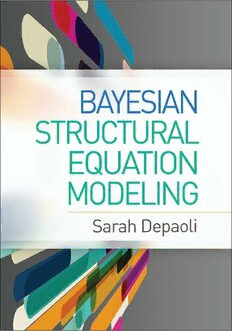Table Of ContentBayesian Structural Equation Modeling
Methodology in the Social Sciences
David A. Kenny, Founding Editor
Todd D. Little, Series Editor
Thisseriesprovidesappliedresearchersandstudentswithanalysisandresearchdesignbooksthat
emphasize the use of methods to answer research questions. Rather than emphasizing statistical
theory,eachvolumeintheseriesillustrateswhenatechniqueshould(andshouldnot)beusedand
howtheoutputfromavailablesoftwareprogramsshould(andshouldnot)beinterpreted. Common
pitfallsaswellasareasoffurtherdevelopmentareclearlyarticulated.
RECENTVOLUMES
PRINCIPLESANDPRACTICEOFSTRUCTURALEQUATIONMODELING,
FOURTHEDITION
RexB.Kline
HYPOTHESISTESTINGANDMODELSELECTIONINTHESOCIALSCIENCES
DavidL.Weakliem
REGRESSIONANALYSISANDLINEARMODELS:CONCEPTS,APPLICATIONS,
ANDIMPLEMENTATION
RichardB.DarlingtonandAndrewF.Hayes
GROWTHMODELING:STRUCTURALEQUATIONANDMULTILEVELMODELINGAPPROACHES
KevinJ.Grimm,NilamRam,andRyneEstabrook
PSYCHOMETRICMETHODS:THEORYINTOPRACTICE
LarryR.Price
INTRODUCTIONTOMEDIATION,MODERATION,ANDCONDITIONALPROCESSANALYSIS:
AREGRESSION-BASEDAPPROACH,SECONDEDITION
AndrewF.Hayes
MEASUREMENTTHEORYANDAPPLICATIONSFORTHESOCIALSCIENCES
DeborahL.Bandalos
CONDUCTINGPERSONALNETWORKRESEARCH:APRACTICALGUIDE
ChristopherMcCarty,MirandaJ.Lubbers,RaffaeleVacca,andJose´ LuisMolina
QUASI-EXPERIMENTATION:AGUIDETODESIGNANDANALYSIS
CharlesS.Reichardt
THEORYCONSTRUCTIONANDMODEL-BUILDINGSKILLS:APRACTICALGUIDE
FORSOCIALSCIENTISTS,SECONDEDITION
JamesJaccardandJacobJacoby
LONGITUDINALSTRUCTURALEQUATIONMODELINGWITHMplus:
ALATENTSTATE–TRAITPERSPECTIVE
ChristianGeiser
COMPOSITE-BASEDSTRUCTURALEQUATIONMODELING:
ANALYZINGLATENTANDEMERGENTVARIABLES
Jo¨rgHenseler
BAYESIANSTRUCTURALEQUATIONMODELING
SarahDepaoli
Bayesian
Structural Equation Modeling
..........................................................................
Sarah Depaoli
Series Editor’s Note by Todd D. Little
THE GUILFORD PRESS
New York London
©
2021TheGuilfordPress
ADivisionofGuilfordPublications,Inc.
370SeventhAvenue,Suite1200,NewYork,NY10001
www.guilford.com
Allrightsreserved
Nopartofthisbookmaybereproduced,translated,storedinaretrieval
system,ortransmitted,inanyformorbyanymeans,electronic,mechanical,
photocopying,microfilming,recording,orotherwise,withoutwritten
permissionfromthePublisher.
PrintedintheUnitedStatesofAmerica
Thisbookisprintedonacid-freepaper.
Lastdigitisprintnumber: 9 8 7 6 5 4 3 2 1
LibraryofCongressCataloging-in-PublicationData
Names: Depaoli,Sarah,author.
/
Title: Bayesianstructuralequationmodeling SarahDepaoli.
|
Description: NewYork,NY:TheGuilfordPress,2021. Series: Methodology
|
inthesocialsciences Includesbibliographicalreferencesandindex.
|
Identifiers: LCCN2021011543 ISBN9781462547746(cloth)
|
Subjects: LCSH:Bayesianstatisticaldecisiontheory. Social
sciences–Statisticalmethods.
| /
Classification: LCCBF39.2.B39D462021 DDC150.1519542–dc23
// /
LCrecordavailableathttps: lccn.loc.gov2021011543
ToMomandDad,
whotaughtmetheonlylimitswefacearethoseweplaceonourselves
And,tomyadorablefamily,Darrin,Andrew,andJacob
Series Editor’s Note
It’sfunnytomethatfolksconsideritachoicetoBayesornottoBayes. It’s
ff
truethatBayesianstatisticallogicisdi erentfromatraditionalfrequentist
/
logic,butit’snotreallyaneither orchoice. Inmyview,Bayesianthinking
haspermeatedhowmostmodernmodelingofdataoccurs,particularlyin
theworldofstructuralequationmodeling(SEM).Thatbeingsaid, having
SarahDepaoli’sguidetoBayesianSEMisatruetreasureforallofus. Sarah
literally guides us through all ways that a Bayesian approach enhances
the power and utility of latent variable SEM. Accessible, practical, and
extremely well organized, Sarah’s book opens a worldly window into the
latentspaceofBayesianSEM.
Although her approach does assume some familiarity with Bayesian
concepts,shereviewsthefoundationalconceptsforthosewholearnedsta-
tistical modeling under the frequentist rock. She also covers the essential
elements of traditional SEM, ever foreshadowing the flexibility and en-
hanced elements that a Bayesian approach to SEM brings. By the time
you get to Chapter 5, on measurement invariance, I think you’ll be fully
ff
hookedonwhataBayesianapproacha ordsintermsofitspowerfulutility,
and you won’t be daunted when you work through the remainder of the
book. Aswithanystatisticaltechnique,learningthenotationinvolvedce-
mentsyourunderstandingofhowitworks. IlovehowSarahseparatesthe
necessarynotationelementsfromthepedagogyofwordsandexamples.
Inmyview,Sarah’sbookwillbereceivedasaninstantclassicandago-
toresourceforresearchersgoingforward. Withclearlydevelopedcodefor
eachexample(inbothMplusandR),Sarahremovesthegauntletoflearning
a challenging software package. She provides wonderful overviews of
vii

